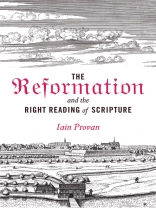In 1517, Luther nailed his Ninety-Five Theses to the door of Wittenberg’s castle church. Luther’s seemingly inconsequential act ultimately launched the Reformation, a movement that forever transformed both the Church and Western culture. The repositioning of the Bible as beginning, middle, and end of Christian faith was crucial to the Reformation. Two words alone captured this emphasis on the Bible’s divine inspiration, its abiding authority, and its clarity, efficacy, and sufficiency: sola scriptura.
In the five centuries since the Reformation, the confidence Luther and the Reformers placed in the Bible has slowly eroded. Enlightened modernity came to treat the Bible like any other text, subjecting it to a near endless array of historical-critical methods derived from the sciences and philosophy. The result is that in many quarters of Protestantism today the Bible as word has ceased to be the Word.
In The Reformation and the Right Reading of Scripture, Iain Provan aims to restore a Reformation-like confidence in the Bible by recovering a Reformation-like reading strategy. To accomplish these aims Provan first acknowledges the value in the Church’s precritical appropriation of the Bible and, then, in a chastened use of modern and postmodern critical methods. But Provan resolutely returns to the Reformers’ affirmation of the centrality of the literal sense of the text, in the Bible’s original languages, for a right-minded biblical interpretation. In the end the volume shows that it is possible to arrive at an approach to biblical interpretation for the twenty-first century that does not simply replicate the Protestant hermeneutics of the sixteenth, but stands in fundamental continuity with them. Such lavish attention to, and importance placed upon, a seriously literal interpretation of Scripture is appropriate to the Christian confession of the word as Word–the one God’s Word for the one world.
İçerik tablosu
1. Introduction: O Little Town of… Wittenberg
Part I. Before There Were Protestants: Long-Standing Questions
2. Scripture and Canon in the Early Church: On Chickens and Their Eggs
3. The Formation of the Christian Canon: The Pressure of the Twenty-Two
4. On the Meaning of Words: The Literal, the Spiritual, and the Plain Confusing
5. The Reading of Scripture in the New Testament: All That the Prophets Have Spoken
6. Literal Reading, Typology, and Allegory in Paul: A Rose by Any Other Name
7. Justin, Irenaeus, and Tertullian: False Economies and Hidden Treasure
8. Origen, Theodore, and Augustine: The Fertility of Scripture
9. How Shall We Then Read?: The Church Fathers, the Reformers, and Ourselves
10. The Septuagint as Christian Scripture: It’s All Greek to Me
11. The Vulgate, the Renaissance, and the Reformation: When in Rome…
Part II. Now There Are Protestants: Scripture in a Changing World
12. The Perspicuity of Scripture Alone: A Lamp unto My Feet
13. The Authority of Scripture: Thy Word Is Truth
14. The Bible, the Heavens, and the Earth: The Beginnings of an Eclipse
15. The Emergence of Secular History: The Way We (Really) Were
16. On Engaging with a Changing World: Fight, Flight, and the Fifth Way
Part III. Still Protesting: Scripture in the (Post)Modern World
17. Source and Form Criticism: Behind the Text
18. Redaction and Rhetorical Criticism: The Persuasive Text
19. Structuralism and Poststructuralism: Texts and Subtexts
20. Narrative Criticism: Getting the Story Straight
21. Social-Scientific and Feminist Criticism Texts as Social Constructs
22. The Canonical Reading of Scripture: The End of Criticism
23. Postscript
Appendix: Modern Developments in Our Understanding of the Biblical Text
Yazar hakkında
Iain Provan is the Marshall Sheppard Professor of Biblical Studies at Regent College. He lives in the Vancouver, Canada area.







![Örtmek Brian Schrag & Julisa Rowe: Community Arts for God's Purposes [Chinese] 貼近神心意的社群藝術 Örtmek Brian Schrag & Julisa Rowe: Community Arts for God's Purposes [Chinese] 貼近神心意的社群藝術](https://static.worldofdigitals.com/thumb_webp/740/9781645083740.webp)




